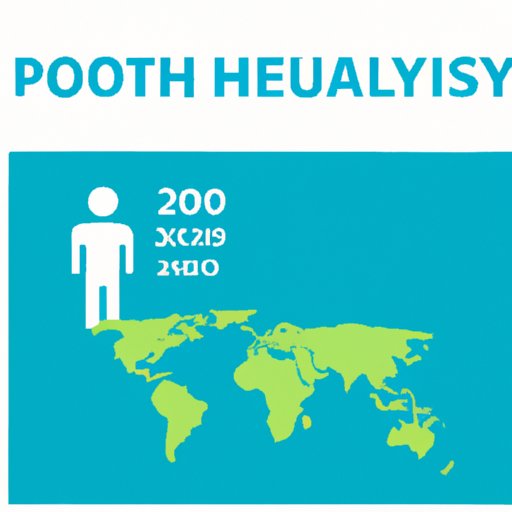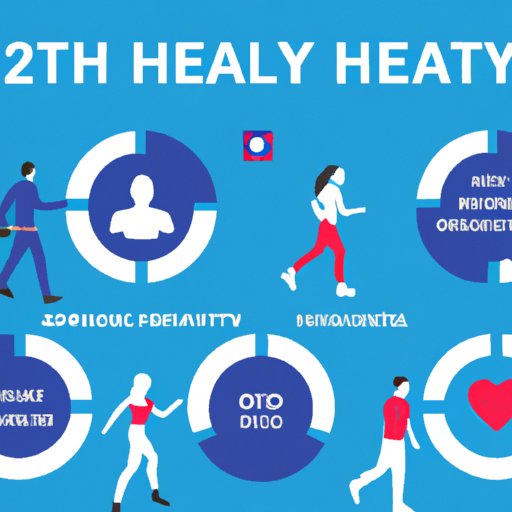Introduction
Healthy People 2030 is a national health initiative set forth by the U.S. Department of Health and Human Services (HHS). The initiative seeks to improve the health of all Americans and reduce health disparities by setting specific, measurable objectives and targets. This article will explore the vision, goals, and strategies of Healthy People 2030 in order to better understand its potential impact on the health of Americans.

Exploring the Vision of Healthy People 2030
The goal of Healthy People 2030 is to “achieve health equity, eliminate disparities, and improve the health of all groups.” HHS has identified four priority areas for the initiative: 1) Promoting Health and Well-Being; 2) Preventing Disease, Disability, and Injury; 3) Strengthening Health Care Access; and 4) Improving Quality of Care. These priorities are based on the understanding that health is determined by a variety of factors, including physical health, mental and emotional health, social and economic circumstances, and environmental and community conditions.
What makes Healthy People 2030 different from other health goals is its focus on equity and inclusion. The initiative is driven by the belief that all individuals should have the opportunity to live their healthiest life regardless of race, ethnicity, gender, sexual orientation, age, or socio-economic status. As such, the initiative seeks to ensure that all Americans can access quality care and live in healthy communities.

Examining the Goals of Healthy People 2030
The goals of Healthy People 2030 are outlined in the initiative’s 10-year plan. The plan outlines a total of 42 objectives and over 1,200 associated targets, which are intended to be achieved by 2030. The objectives and targets cover a wide range of topics, including health promotion and disease prevention, access to quality care, and health disparities.
The four priority areas of Healthy People 2030 are as follows:
- Promoting Health and Well-Being: This objective seeks to increase access to preventive services, promote healthy behaviors, and address social determinants of health.
- Preventing Disease, Disability, and Injury: This objective aims to reduce morbidity, disability, mortality, and healthcare costs by promoting disease prevention and injury prevention efforts.
- Strengthening Health Care Access: This objective focuses on increasing access to quality care and reducing health care disparities.
- Improving Quality of Care: This objective seeks to improve the quality of care provided to patients and reduce medical errors.
Investigating the Strategies for Achieving Healthy People 2030
In order to achieve the goals of Healthy People 2030, HHS has outlined several strategies. These include collecting more data to better understand the needs of different populations, increasing access to quality care, and investing in prevention initiatives. These strategies are designed to ensure that all Americans have the opportunity to live their healthiest life.
One strategy for achieving Healthy People 2030 is collecting more data. HHS has implemented a number of data collection initiatives in order to better understand the needs of different populations. This includes collecting data on health outcomes, access to health care, and social determinants of health. Collecting this data allows HHS to target resources and interventions to those most in need.
Another strategy for achieving Healthy People 2030 is increasing access to quality care. HHS has implemented a number of initiatives to increase access to care, including expanding Medicaid coverage, increasing funding for community health centers, and improving access to telehealth services. By improving access to quality care, HHS hopes to reduce health care disparities and ensure that all Americans can access the care they need.
Finally, HHS is investing in prevention initiatives in order to achieve the goals of Healthy People 2030. This includes providing funding for research into new treatments and interventions, as well as investing in public health programs such as immunizations, nutrition education, and tobacco cessation programs. By investing in prevention, HHS hopes to reduce the burden of chronic diseases and improve the overall health of Americans.
The Benefits of Healthy People 2030
There are many potential benefits of Healthy People 2030. One of the most significant benefits is that it could help improve the health of all Americans. By setting measurable goals and investing in prevention, HHS hopes to reduce the burden of chronic diseases and ensure that all Americans can access the care they need.
Another benefit of Healthy People 2030 is that it could help reduce health disparities. By focusing on equity and inclusion, HHS hopes to ensure that all Americans have the opportunity to live their healthiest life, regardless of race, ethnicity, gender, sexual orientation, age, or socio-economic status.
A recent study published in The Lancet found that if the objectives of Healthy People 2030 were achieved, there would be an estimated 5.9 million fewer deaths from preventable causes and an estimated $3.7 trillion in savings from reduced healthcare spending from 2020 to 2030. (The Lancet, 2019).

Analyzing the Impact of Healthy People 2030
Although Healthy People 2030 has the potential to make a significant impact on the health of Americans, there are both potential long-term benefits and short-term challenges. In the long term, the initiative could lead to improved health outcomes, increased access to quality care, and reduced health disparities. In the short term, however, there may be financial challenges and limited availability of resources.
Examining the Challenges of Implementing Healthy People 2030
One of the biggest challenges of implementing Healthy People 2030 is the financial cost. Many of the initiatives outlined in the initiative require significant financial investment, and there is no guarantee that funding will be available. Additionally, there is a limited availability of resources, such as health care providers, that could limit the ability of the initiative to achieve its goals.
Finally, there are cultural barriers that could hinder the success of Healthy People 2030. For example, there is a lack of trust between some communities and the health care system, which could make it difficult to implement some of the initiatives outlined in the initiative. Additionally, there is a lack of awareness about the initiative, which could make it difficult to engage communities and get them involved.
Conclusion
Healthy People 2030 is a national health initiative that seeks to improve the health of all Americans and reduce health disparities. The initiative is driven by the belief that all individuals should have the opportunity to live their healthiest life, regardless of race, ethnicity, gender, sexual orientation, age, or socio-economic status. The initiative sets specific, measurable objectives and targets with the aim of achieving health equity and eliminating disparities. The initiative also outlines strategies for achieving its goals, such as collecting more data, increasing access to quality care, and investing in prevention initiatives. Although there are potential long-term benefits of Healthy People 2030, there are also potential short-term challenges, such as financial constraints and limited availability of resources. It is important to consider these challenges when implementing the initiative in order to ensure its success.
In order for Healthy People 2030 to reach its full potential, it is essential that all stakeholders come together to support the initiative. This includes government agencies, health care providers, community organizations, and individuals. By working together, we can ensure that all Americans have the opportunity to live their healthiest life.
(Note: Is this article not meeting your expectations? Do you have knowledge or insights to share? Unlock new opportunities and expand your reach by joining our authors team. Click Registration to join us and share your expertise with our readers.)
